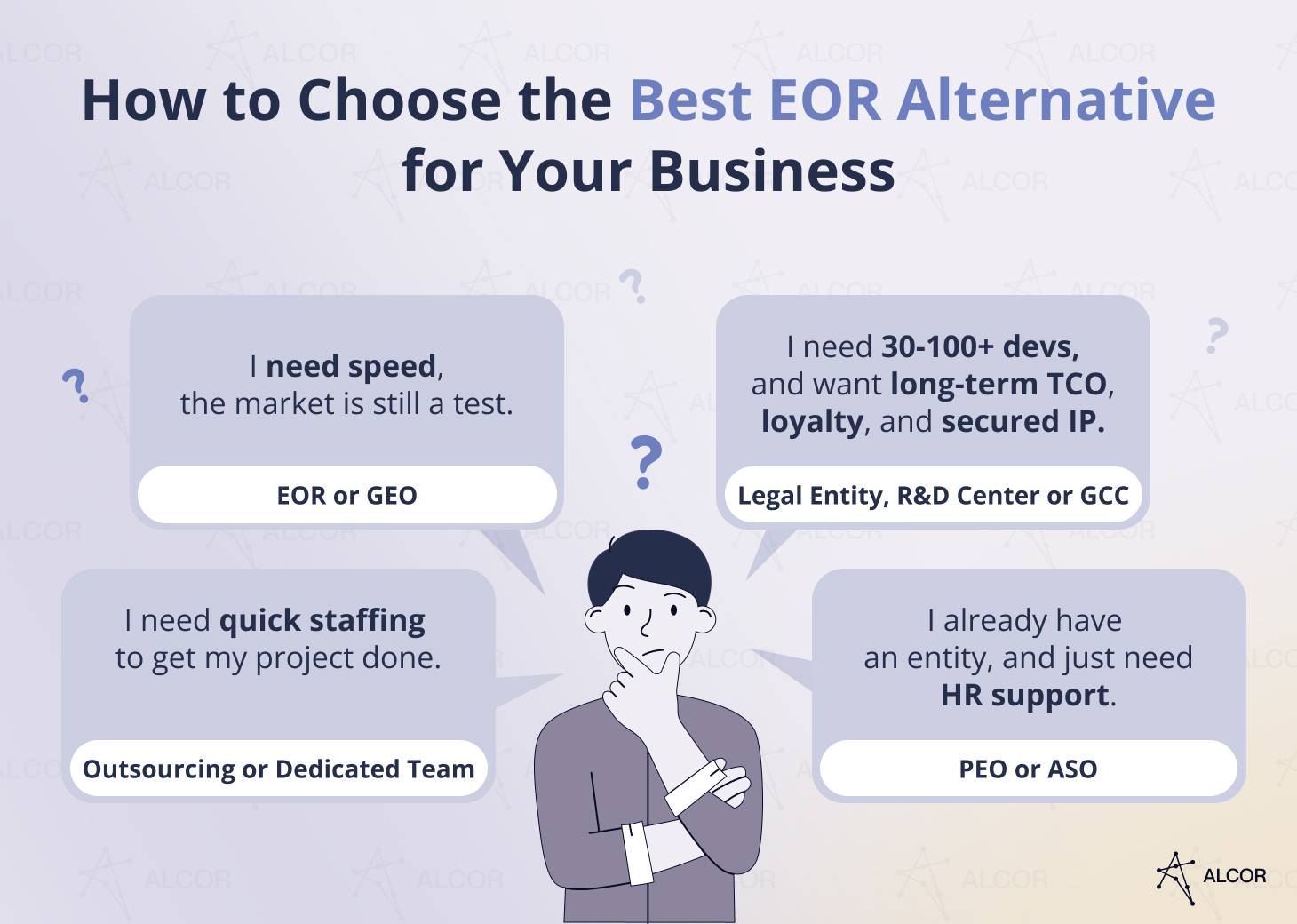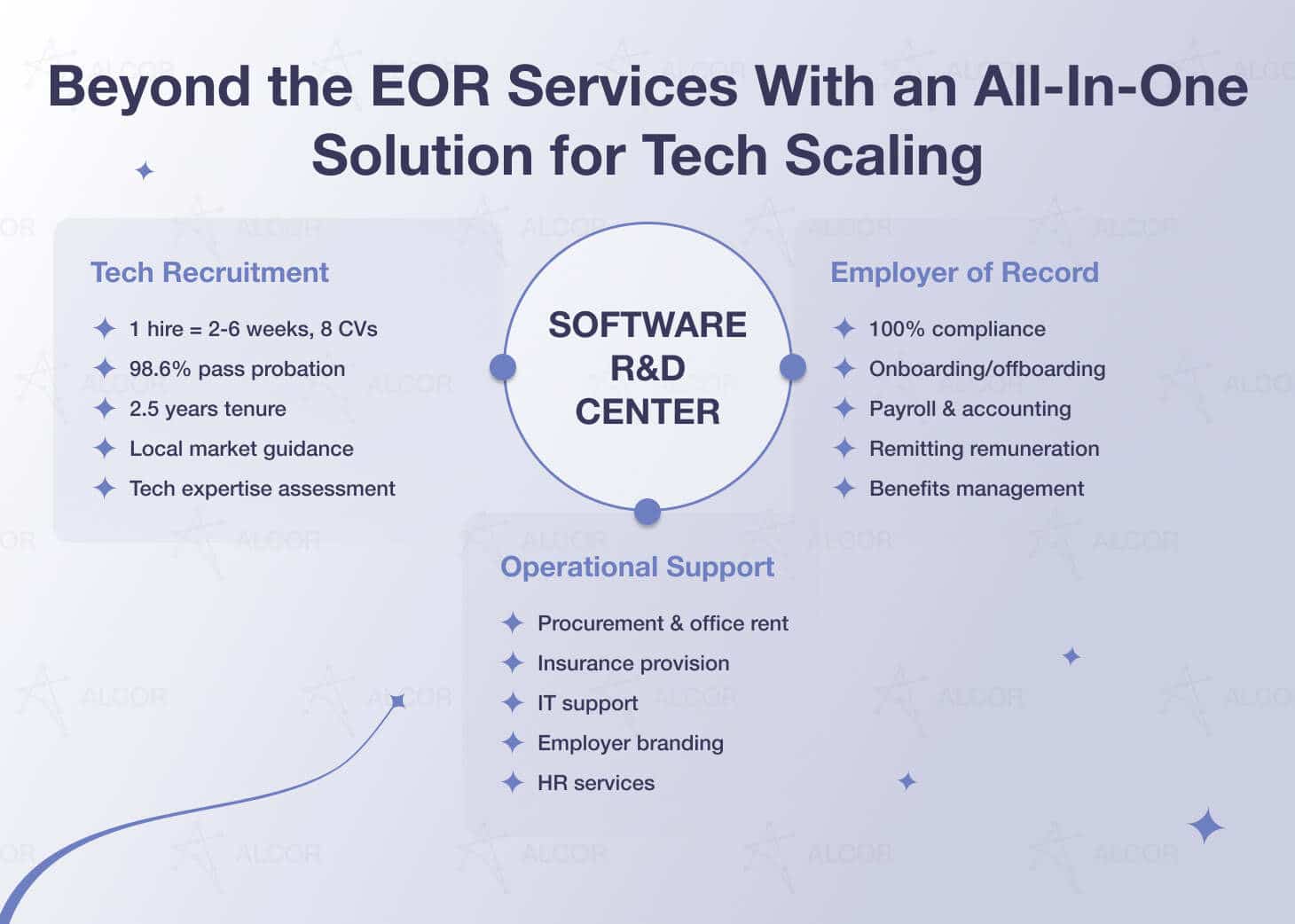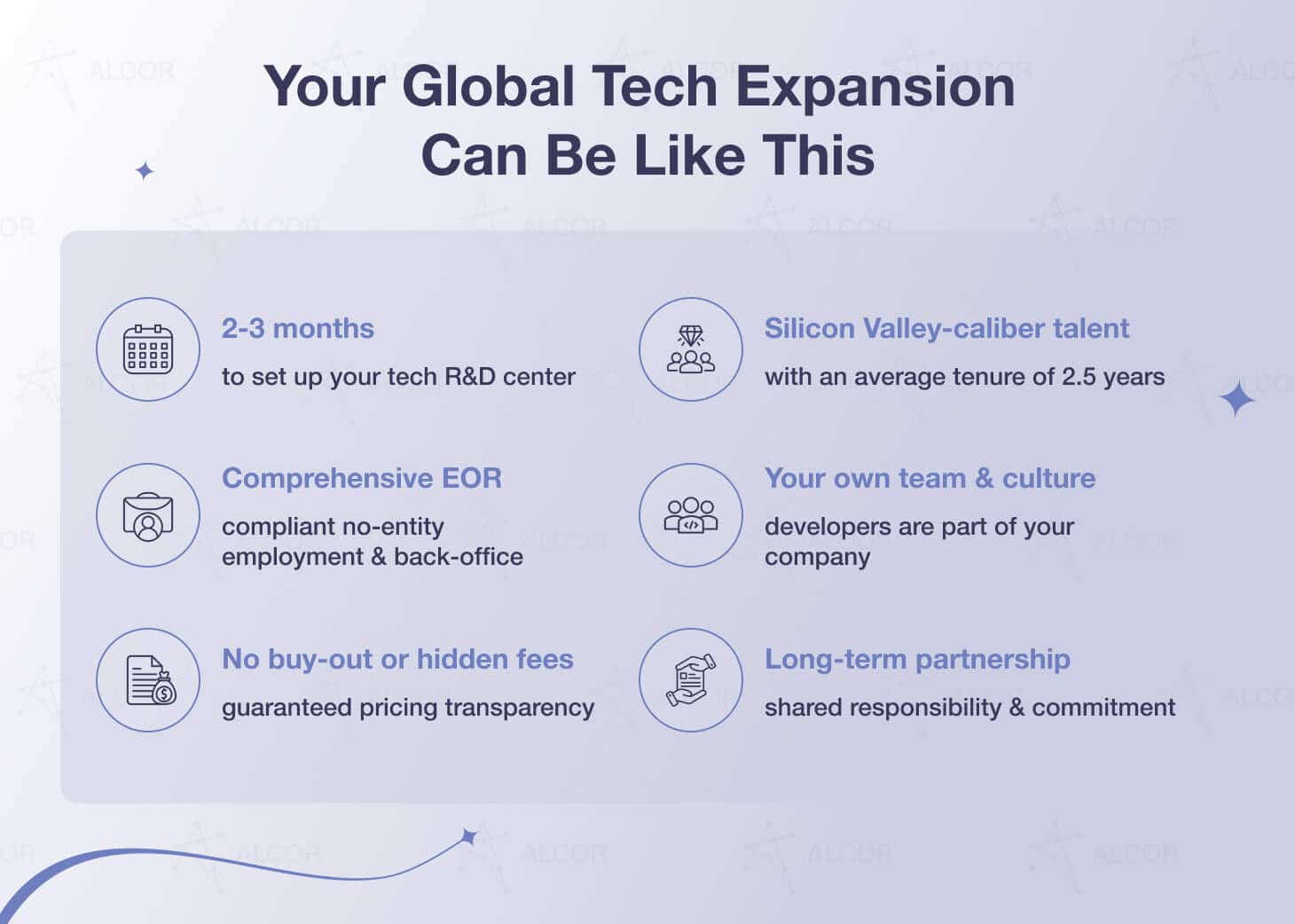In 2025, tech companies are seeking PEO alternatives alongside traditional EOR, GEO, and ASO options. Deloitte reports that about 70% of tech leaders have brought work back in-house, keeping only targeted outsourcing for payroll, ops, and admin. Riding that push for greater control and ownership, more businesses are turning to strategic models like a tech R&D center, own legal entity, and GCC. They guarantee IP and security, reduce markups, and build integrated, co-located teams aligned to your roadmap.
If your current provider outsources some critical functions to other vendors, buries hidden costs in fine print, and routes every request through a ticket queue, you’re paying in lost transparency and efficiency. Alcor gives you clarity and control with your own tech R&D center, packed with tech recruitment, Employer of Record service, and full operational support. You get Valley-caliber engineers, direct management, and lower total cost of ownership (TCO) as your team grows – from 10 to 100 devs in a year.
In this guide on alternatives to traditional PEO, ASO, EOR, and GEO services, you’ll learn where each model wins, what it really costs, and when to switch. I’ll compare speed to market, security, pricing clarity, team loyalty, and support quality so that you can pick the right services and provider without the guesswork.
Key Takeaways
- Classic EOR, PEO, GEO, and ASO help you move fast and reduce legal risk, but they often leave recruitment and ops outside the model, creating fragmented accountability across providers.
- If you want long-term control, loyalty, and transparent budgeting, build your own legal entity with an in-house team or launch a software R&D center/GCC, so the capability stays within your company.
- Outsource side projects with tight timelines, and use a dedicated team when you need immediate talent capacity to cope with a workload, while remembering that the devs remain employed by the vendor.
- Choose a cooperation model by balancing time horizon and scale, and ask yourself whether you are optimizing for speed this quarter or ownership over the next two to three years.
- Alcor unifies tech recruiting, compliant employment, and ops support into a single engine to launch your own tech R&D center. By using our Employer of Record services in Mexico and other locations, you save 3.5 months on legal entity while scaling your team from 5 to 30 engineers in just 3 months – real delivery velocity and no hidden fees.
Brief Definitions and Weaknesses
EOR, PEO, GEO, and ASO help you start fast and lower legal risk, but they rarely own recruitment end to end. Automation can replace real support and becomes rigid when you need exceptions. Payroll and contract tweaks often don’t fit templates, and pricing that looked simple grows with add-ons and third parties. Standard HR works for basics but feels thin for senior hires and tailored benefits. Day-one operations still land on your plate.
I’ll say it as it is: if you’re still stitching together three providers to hire one engineer, you’re paying a “coordination tax.” Want fewer seams and more control? Before I dive into alternatives, let’s anchor the basics:
- An Employer of Record (EOR) is a provider that legally employs your people where your company has no entity. You lead the work, and the EOR runs contracts, payroll, taxes, and compliance.
- A Professional Employer Organization (PEO) co-employs with you in one country. You manage the team day to day, and the PEO handles HR, payroll, and benefits, so you don’t have to build that engine yourself.
- A Global Employer Organization (GEO) is EOR at scale: one umbrella provider employing your people across multiple countries while you direct delivery and standards.
- An Administrative Services Organization (ASO) runs admin without co-employment. You remain the sole employer and decision-maker, the ASO processes payroll and benefits, and takes routine HR off your plate.
On paper, these models look great. Faster starts, fewer legal headaches, and a single provider for messy HR services. What’s not to like? But the same cracks show up across EOR, PEO, GEO, and ASO.
- Recruitment isn’t end-to-end. Most EOR and GEO providers don’t build a customized full-cycle recruitment process. They may offer sourcing or basic screening, but many things like EVP creation, technical and English assessments, and culture-fit interviews drift to other vendors, and ownership blurs.
- Automation can get rigid. This is more common with EOR and GEO, which provide AI-driven platforms for workforce management. Video guides, FAQ articles, and AI chatbots end up replacing real human support. Clients are left to navigate platform widgets on their own while dealing with endless ping-pong communication between customer support and other departments.
- Low adaptability in payroll and contracts. Need to add equity or IP protection clauses? Pay bonuses, one-off premiums, or do gross-to-net recalculations? These tweaks often don’t align with the platform’s default settings. Changes take time and create noise for managers.
- Pricing clarity erodes. Bundles look simple at first. Then come add-ons, hidden fees, and surcharges for third-party services. The real cost creeps up as you scale.
- One-size-fits-all HR feels thin (especially with PEO or ASO). Standard policies are fine for common cases, but leadership hires, tailored benefits, or nonstandard probation terms need judgment calls, not forms.
- Operations still land on your plate. Tooling access, equipment, office, and day-one productivity can sit between providers.
I suggest asking yourself one question: Do we have a single accountable partner from sourcing to the first productive sprint?
If this resonates, the next section will walk you through…
Alternatives to Employer of Record and Similar Models
If you need speed without long setup, start with EOR or GEO and hire immediately while you validate the market. If you want long-term control, loyalty, and clear unit economics, build on your own legal entity and run a software development or R&D center, or broaden into a GCC. Remember that an entity takes time and resources, while an R&D center gives you the same in-house capability with operational lift handled for you. Use outsourcing when the goal is a defined outcome on a tight timeline, but expect vendor control, team reshuffles, and buyout fees. Use a dedicated team to bridge capacity fast, and plan a conversion path if the work becomes core.
You want speed without surprise costs, control without busywork, and a team that feels like your in-house one. Fair ask. Let’s line up the real options, and compare what they actually deliver:
|
Speed to market |
IP protection | Pricing transparency | Team loyalty | Customer support |
Сontrol |
|
| R&D center | Medium | Very high |
High |
Very high | Very high |
High |
| EOR |
High |
Medium | Medium | High | Medium |
Medium |
| PEO |
N/A |
Medium | Medium | High | Medium |
High |
| ASO |
N/A |
Medium | Medium | High | Medium |
High |
| GEO |
High |
Medium | Medium | High | Medium |
Medium |
| Legal entity |
Low |
Very high | Very high | Very high | N/A |
Very high |
| GCC |
Low |
Very high | High | Very high | High |
High |
| Outsourcing |
Very high |
Low | Low | Low | Low |
Low |
| Dedicated team |
High |
Low | Low | Medium | Medium |
Medium |
Now let’s look a little more in-depth.
Your Own Legal Entity
Think of a legal entity as planting your flag. It’s your company registered in-country, hiring tech talent directly, running payroll, signing leases, and owning every decision. No intermediary vendor. You get full control over expenses, team, and IP security, while your dev team is fully integrated into your culture and practices.
Long story short, you own everything. Including liabilities. So let’s talk about where you need to weigh all the pros and cons.
Firstly, it takes time. Setting up an entity somewhere in Romania or Mexico can take up to 3 months due to local registration and red tape. And you’ll need to become visible to candidates – think local employer branding, career pages in the local language, and a presence in engineering communities – so the right developers actually find you.
Secondly, you’ll need to handle recruitment, compliance, payroll, and HR, either with your in-house resources or by delegating them to local agencies. If headcount is small or demand is uncertain, fixed overhead can outweigh the benefits.
Ask yourself: do we have the time, team, and upfront budget to build a real offshore branch? And will the expected headcount and timeline deliver a clear break-even?
Software Development or R&D Center
An R&D center is your in-house hub for product development. It sits under your legal entity (or starts fast via EOR or GEO), giving you control over team, software development, security, and costs.
You might ask how this differs from a legal entity. In short, an R&D center is your own development team, just stood up faster. With a standalone entity, you must handle hiring, payroll, compliance, and admin operations yourself. With an R&D center model, those operational functions are handled for you, so you don’t juggle multiple vendors or expand non-core staff. That’s exactly what Alcor offers under its 360-degree ops coverage, all in one place.
You get IP control, unified tooling, and a culture that feels like HQ, which boosts loyalty and lowers TCO over time. Decisions are yours, and the trade-off is maturity: you’ll need local leadership, governance, and clear SLAs for HR and payroll.
Let me ground this in a real case. Alcor set up a fully-fledged tech R&D center for People.ai, an AI development company based in LA, which had previously split work across vendors and lost efficiency and speed. We became the single accountable partner for legal setup, payroll, office, and hiring, launching a ready R&D office in just a month. Alcor hired and onboarded 25+ rare-skill engineers for People.ai, with 98.6% passing probation, while also ensuring full compliance with both the US and Ukrainian laws.
Global Capability or Captive Center
A Global Capability Center (GCC) – also called a Captive Center – is your multi-function hub abroad that serves only your company. Think engineering plus data, security, FinOps, CX, or analytics under one governance model. If an R&D center is typically engineering-focused, a GCC is the broader operating model that runs multiple capabilities simultaneously, with shared tooling, standards, and SLAs.
You also get ownership of your team and IP, a unified culture, and clear budgets. Still, GCC needs maturity: country setup, leadership, risk management, and consistent SLAs for HR, payroll, and office services. It isn’t a “switch on Friday, live on Monday” move. Expect months to launch and an operating cadence you must actively run.
Outsourcing
Outsourcing is a vendor delivering a defined project outcome under a statement of work. Your company manages roadmap priorities, while the provider delivers services on its end. Think of it as “operate this function” or “ship this scope,” not “join our team.” If you need a 24/7 L2 desk or a well-scoped feature train, a strong provider can spin it up faster than you could hire.
Control and knowledge drift to the vendor. Pricing appears clear at first, but vendors may bill senior rates but staff junior or mid-level engineers, reshuffle teams midstream, and charge more just to sustain their developers on the bench. When you want to keep the best contributors, buyout fees can be steep. And culture? It lives mostly with the provider, so loyalty accrues to them, not to you.
You might ask, “What is outsourcing doing here?” It may sit in a different lane from other models, but leaders still weigh it on par with other alternatives to traditional EOR and PEO services. But I’d say if IP ownership, an in-house team, and investment readiness are strategic for you, favor your legal entity, a tech R&D center, or a GCC over a vendor-run model.
Dedicated Team
A dedicated team model is an external tech squad that you lease to cope with seasonal workload and project-specific talent gaps. Assigned developers of an outstaffing vendor work specifically on your project for a predetermined period of time. Their engagement with your internal engineers, development processes, and standards may resemble an in-house team, but it isn’t. The extended tech team remains employees of the provider, not your tech company, and may produce a lower-quality end product.
If you need senior hands for a side project or to test new product features, you can ramp in a week or so instead of months. The services bundle (HR, payroll, equipment) stays with the vendor, so your managers focus on delivery, not paperwork.
Yet when rates seem fixed, extra invoices often appear for laptops, licenses, training, or replacements, and buyouts can be costly. IP and access must be nailed down in contracts, not left to “how we usually do it.” And when priorities shift, you still carry the run-rate unless the contract flexes. A dedicated team will not fix the staffing gap long-term, unlike a fully-fledged tech R&D center, with the Employer of Record in Latin America or Eastern Europe, coupled with IT recruitment and ops.
How to Choose the Best EOR Alternative for Your Business
First of all, I would suggest asking yourself three main questions:
- Am I prioritizing speed this quarter, or ownership for the next 2-3 years?
- How big and durable is my strategy in this country (pilot vs 30-100+ devs)?
- What must stay inside my tech company for IP, security, and culture to work?
If you’re clear on those, the model choice gets a little bit easier. Below, I’ll provide you with practical answers and the fits that usually work:
- EOR or GEO: If you’re piloting markets for up to a year with a small team of 1-20 people, and no need for legal entity;
- Legal Entity, R&D Center, or GCC: If you plan to scale your team with 30-100+ devs and want long-term ownership, loyalty, and clear pricing;
- PEO or ASO: If you already have an entity and just need HR & admin support;
- Outsourcing or Dedicated Team: If the need is a one-off, well-scoped project with a tight deadline.
If you still feel torn, ask one last filter: “Do I only need one tool today, or will recruiting and ops land back on our plate tomorrow?” If it makes you wonder, I have one last thing to tell you…
Alcor – a Trusted Software Development Center Provider
You want speed without admin drag, and ownership without third parties. That’s exactly what we build: your software development center, fully supported end-to-end, so you can ship faster.
Why tech leaders pick Alcor:
- Single accountable partner. One team to recruit, employ, and operate – no daisy chain of vendors.
- Senior talent at scale. Top-10% senior engineers, hired for your stack and culture.
- Employer of Record in Poland, and other Eastern European and Latin American locations, or Contractor of Record services if you decide to hire under B2B.
- Operational muscle. We handle procurement & office rent, insurance provision, employer branding, and HR services – so your leads focus on product delivery instead.
Trusted by renowned US and EU product tech companies like Intel 471, Dotmatics, Ledger, and others.
Ready to replace the coordination tax with real velocity? Make Alcor your all-in-one build partner for the tech R&D center – from first hire to first productive sprint.



